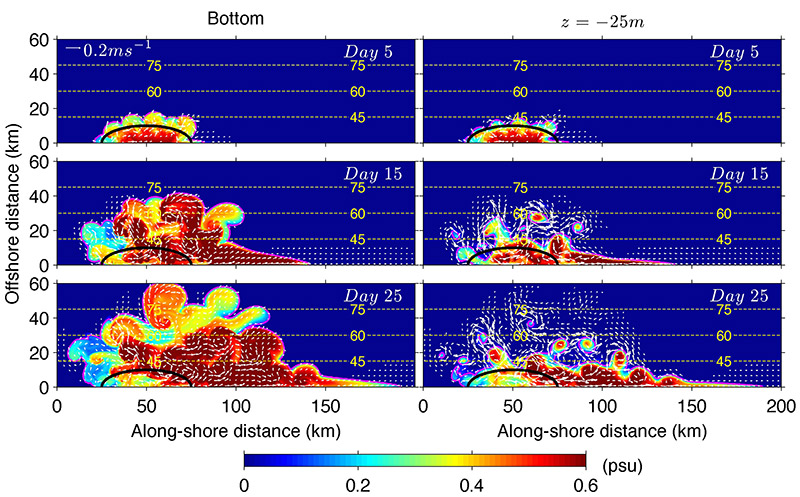Ongoing Projects
Polynyas in Coastal Antarctica (PICA): Linking Physical Dynamics to Biological Variability
Lead PI: Gordon Zhang
co-PIs: Stephanie Jenouvrier (WHOI), Rubao Ji (WHOI), Yun Li (USF), and Ted Maksym (WHOI)
This project focuses on the connections between physical environment (atmosphere, sea ice, ocean and seafloor) and key ecosystem components in Antarctic coastal polynyas, including plankton and emperor penguin. The objective is to investigate the underlying mechanisms of observed spatiotemporal variability among the Antarctic coastal polynyas. The main approach is to combine coupled dynamic modeling with existing observations in the coastal polynyas.
Shelfbreak Frontal Dynamics: Mechanisms of Upwelling, Net Community Production, and Ecological Implications
Lead-PI: Dennis McGillicuddy
Co-PIs: Heidi Sosik and Gordon Zhang (WHOI); Walker Smith (VIMS); Rachel Stanley (Wellesley); Jeff Turner and Christian Petitpas (UMass-Dartmouth)
This interdisciplinary project is to study the biophysical interaction at the Mid-Atlantic Bight shelfbreak frontal region. The objectives are to reveal whether the biological productivity at the shelfbreak frontal region is high and to understand the underlying mechanism and the physical and biological controls.
Impact of Gulf Stream Warm-core rings on Gulf of Maine Circulation
Lead PI: Gordon Zhang
co-PI: Yizhen Li
This study aims to investigate the fundamental dynamics and regional influences of the interaction between the Gulf of Maine and Slope Sea on short time scales associated with the impingement of Gulf Stream warm-core rings at the shelf edge.
Super Reefs: Ensuring Coral Reef Futures At Sea and On Land
Lead PI: Anne Cohen
co-PI: Gordon Zhang, Michael Fox
This study is to collaborate with the Nature Conservancy to support development of a Super Reef Marine Protected Area (MPA) in the Republic of the Marshall Islands (RMI). Our work there will establish the much-needed framework for protection of coral reefs.
Past Projects
Integrated Modeling and Analysis of Physical Oceanographic and Acoustic Processes
Lead PI: Tim Duda
co-PIs: Jim Lynch, Ying-Tsong Lin, Karl Helfrich, Gordon Zhang, etc
My portion of the project is to study internal wave dynamics at a shelfbreak environment, including the generation, propagation, transformation, as well as the influences of external factors, such as shelfbreak canyons, on the wave processes.
Dynamics of frontal meandering and related exchange processes at the shelfbreak south of New England
Lead PI: Gordon Zhang
co-PI: Glen Gawarkiewicz
This project is to study the dynamics of various frontal processes at the shelf break south of New England, including the mean circulation, frontal meander, frontal upwelling, biophysical interaction and cross-frontal exchange. The influences of external forces on the frontal processes, such as the Gulf Stream warm-core rings, are also targeted.
Circulation and transport in the Hudson Shelf Valley
Lead PI: Gordon Zhang
co-PI: Steve Lentz
The objectives of this project are to understand the processes controlling the wind-driven along-valley transport and the vertical structure of the flow in the Hudson Shelf Valley, a unique feature that cuts across the entire Mid-Atlantic Bight continental shelf and connect the Hudson estuary directly to the open ocean.

Time series of modeled salinity anomaly (color) and velocity (white vectors) on the sloping bottom (left) and at 25 m below the surface (right) show two dense water transport pathways: one narrow coastal current to the right; the other full of eddies going down the slope while turning to the right gradually. Black solid lines outline the polynya area; dashed yellow lines indicate isobath contours (deepens toward north). (Weifeng (Gordon) Zhang)
The dispersal of dense water formed in coastal polynyas in the Arctic Ocean
This project studies how the dense water generated by ice formation in coastal polynyas (an area of open water surrounded by sea ice) travels across the continental shelf and eventually drains into the deep basin. In particular, I focus on the influences of eddies, ambient currents, topography and coast to the dense water propagation. As the polynya-sourced dense water is a major source of the Arctic halocline water that separates the surface cold layer (where sea ice resides) from the warm water underneath, studying the transport of the dense water on the shelves is important for understanding the Arctic climate.